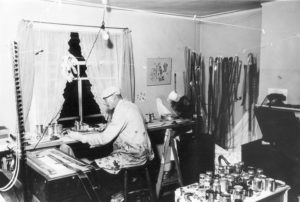Image courtesy of the Govett-Brewster Art Gallery
After a brief respite, we are thrilled to re-launch our Full Aperture screening series, dedicated to showcasing experimental, artist, and nonconformist film. This autumn we will present three shows on Fridays at Pietra Gallery at 912 Julia Street. We love the look and feel of the space, which complements these films particularly well.
We’re particularly excited to begin the series with a program centered on several films by Len Lye: creator of some of the earliest abstract animated films, pioneer of the scratch film, and genuine cinematic innovator. His films showcase dazzling color processes, along with a richly diverse and resourceful filmmaking vocabulary. And, they’re frequently just delightful to watch: filled with winking humor and mesmerizing images and dense polyrhythms, and often capturing a wild upbeatness and sense of wonder that makes them stand out from more controlled work.
This isn’t surprising, coming from a filmmaker memorably once described as “the least boring person who ever lived.” Lye’s personality was resolutely open-minded, unconventional, and experimental. Born in 1901 in New Zealand, Lye’s childhood was marked by a number of unconventional experiences, including a period living at a remote lighthouse while his stepfather worked as a keeper. Voraciously self-educated, as a young man Lye worked his way to Sydney, spent months living in Samoa, and eventually bought another man’s papers and stole onto a ship bound for London, working as a stoker in the ship’s engine room. Along with his exotic background, his adventures gave him an element of novelty as he established himself in London, while his actual ideas presented a fresh perspective to artists and viewers hungry for new approaches.
Lye’s painting, drawing, and film work reflected his deep interest in “folk” art of native cultures and in the role of the unconscious. He chafed at the traditional values of his native country and was captivated by art of Maori, Samoan, and Australian Aboriginal cultures, which to him appeared to come from nowhere, or directly from the artist’s essence. Lye felt that, being unburdened by values of the Western art canon, artists in non-Western cultures were able to capture something more natural and organic than by hewing to traditions of representation and subject. While we can recognize the fallacy in idolizing artistic “primitivism,” it’s fair to say that Lye was galvanized by the discovery of other artistic paths than that which he had received.
He was able to pour these interests into a practice that was highly distinctive and recognizable pretty much from the start, and that eventually encompassed practices of kinetic sculpture and elements of Earth art. Lye is seen by many as New Zealand’s most famous artist, and although his film work is highly significant, film was also simply one medium of several to express his lifelong goal of expressing natural motion and kinetic energy.
Unfortunately, Lye’s filmmaking career was cursed by difficulties in realizing his ideas, despite his early reputation as the “English Walt Disney.” He had chronic difficulties obtaining funding, created content that was too radical for corporate funders, and held divergent opinions about the role of cinema and television – mainly that both should be used to promote innovative art in moving images, not commerce. However, Lye’s British films of the ‘30s were mostly advertising commissions: by cigarette manufacturers, Shell Oil, Imperial (now British) Airways, and the British General Post Office (GPO) Film Unit. Such films were seen initially as public service announcements before a feature, were popular but divisive, and were covered by film publications. They’re a collective joy to watch and often nod only in the slightest way to their supposed subject. They blend both cameraless and stop-motion animation, along with painting directly onto film – a technique that Lye is credited with either inventing or doing viably for the first time. The Birth of the Robot (1936) even features a gold homunculus bearing a very close resemblance to C-3PO. By Trade Tattoo (1937), Lye was working with the Technicolor lab at unheard-of levels of complexity, layering colors and images into a delirious kaleidoscope, while pushing lab technicians and funders to their limits.
Lye began working on 16mm when he moved to New York during World War II, and most of his films from this period, while just as amazing, feel notably less innocent and carefree. His completed films were still often commissions (Rhythm, 1957) and his filmmaking reputation was secure, but he experienced long fallow periods during which he was unable to obtain funding.
Still, several of his later U.S. and New Zealand films are masterpieces that form the backbone of our program. Color Cry (1952) reflected the obscure austerity of abstract expressionist contemporaries like Barnett Newman. Tal Farlow (1958/1981) and Free Radicals (1958/1979) are masterful scratch films that create incredibly complex movements, achieving quasi-3D effects, and although he earned accolades and prize money, Lye was so fed up with obtaining funding for films by the late ‘50s that he essentially quit filmmaking to focus on kinetic sculpture. He tinkered with and revised some films, and completed the more austere scratch film Particles in Space (1979) just before his death.
Lye’s spirit was truly experimental and his films anchor our program also featuring Abigail Child’s masterpiece Mutiny (1983) and Paul Glabicki’s fascinating Object Conversation (1985). More on these two films next week.
TB
Further reading
Len Lye: A Biography, by Roger Horrocks, is a comprehensive look at the artist’s fascinating life that does not dwell overly on his films.
The Govett-Brewster Art Gallery in New Plymouth, NZ, which houses the Len Lye Centre, contains lots of helpful information about his life and films on their website. They also sell several books on or relating to his art.
http://govettbrewster.com/len-lye/




